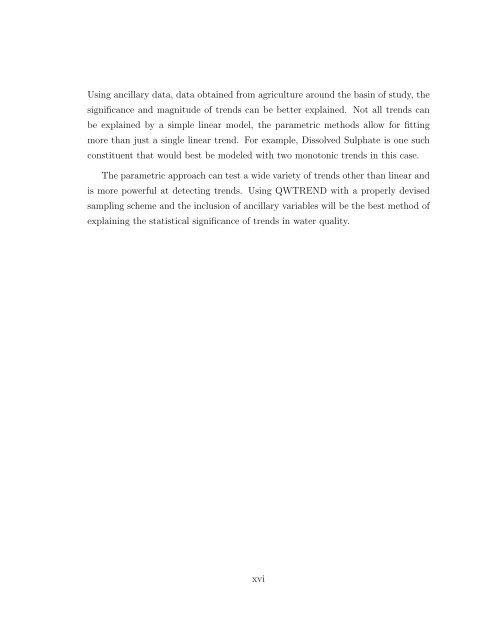Statistical Analysis of Trends in the Red River Over a 45 Year Period
Statistical Analysis of Trends in the Red River Over a 45 Year Period
Statistical Analysis of Trends in the Red River Over a 45 Year Period
You also want an ePaper? Increase the reach of your titles
YUMPU automatically turns print PDFs into web optimized ePapers that Google loves.
Us<strong>in</strong>g ancillary data, data obta<strong>in</strong>ed from agriculture around <strong>the</strong> bas<strong>in</strong> <strong>of</strong> study, <strong>the</strong><br />
significance and magnitude <strong>of</strong> trends can be better expla<strong>in</strong>ed. Not all trends can<br />
be expla<strong>in</strong>ed by a simple l<strong>in</strong>ear model, <strong>the</strong> parametric methods allow for fitt<strong>in</strong>g<br />
more than just a s<strong>in</strong>gle l<strong>in</strong>ear trend. For example, Dissolved Sulphate is one such<br />
constituent that would best be modeled with two monotonic trends <strong>in</strong> this case.<br />
The parametric approach can test a wide variety <strong>of</strong> trends o<strong>the</strong>r than l<strong>in</strong>ear and<br />
is more powerful at detect<strong>in</strong>g trends. Us<strong>in</strong>g QWTREND with a properly devised<br />
sampl<strong>in</strong>g scheme and <strong>the</strong> <strong>in</strong>clusion <strong>of</strong> ancillary variables will be <strong>the</strong> best method <strong>of</strong><br />
expla<strong>in</strong><strong>in</strong>g <strong>the</strong> statistical significance <strong>of</strong> trends <strong>in</strong> water quality.<br />
xvi
















